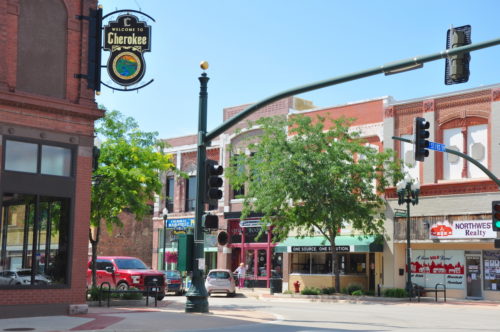
Cherokee’s Historic Downtown is listed on the National Register of Historic Places. Photo courtesy of Cherokee Chamber of Commerce
By Ashley Rullestad
The town of Cherokee, the county seat of Cherokee County, is home to approximately 5,000 Iowans who have chosen to call the scenic Little Sioux River Valley home. The town is situated about 60 miles northeast of Sioux City and 60 miles southwest of the Iowa Great Lakes region. The area where Cherokee is situated was formed by three glaciers creating the valley. The Little Sioux River winds through Cherokee County, making it one of the most picturesque areas in northwest Iowa.
According to The Chronicle Times, “Many high points afford a beautiful view, best of all is seen from the top of Pilot Rock, a huge boulder of red Sioux quartzite left by the last glaciations. On a hill south of Cherokee, the rock served as a guidepost and meeting place for Indians and white explorers and has given the Little Sioux the name of ‘Woven Rock River.’”
The Cherokee County web site has compiled additional historic facts from The Chronicle Times, noting that Cherokee County was one of the 49 counties divided from Indian Treaty lands by the Third Iowa Assembly in 1851. The counties created were given names of famous men, Indian tribes, and battles — apparently at the legislators’ whims.
Soon after, pioneers made their way into the area. In 1856, Robert Perry, an Irish immigrant, built the county’s first home. Scouts from the Milford Massachusetts Emigration Co. decided to settle their colonists in the area based on Perry’s description of the valley. The original town, Old Cherokee, was founded in 1857, just north of the present county seat on the west side of the river.
TO READ THE ENTIRE STORY AND OTHER FASCINATING STORIES ABOUT IOWA HISTORY, subscribe to Iowa History Journal. You can also purchase back issues at the store.
